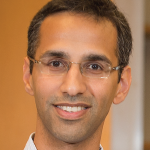Five years after the ARC was established, is it really making a difference? “Absolutely,” says Dr. Nigrovic. “To date, we have reviewed over 60 aims pages. Of those, more than half of the proposals submitted to granting agencies have been funded. Along the way, investigators are learning from each other how to write grants better. Thus, the ARC is serving an important educational function, especially for scientists at the beginning of their careers.
“I would love to see the ARC become a model for the future of preparing investigators for grant funding. My advice to anyone interested in replicating it is this: Just try it. It is incredibly easy to implement, and it is a high-impact intervention. Keep things simple, be neutral, and always be supportive.”

Dr. Rao
One ARC success story is Deepak A. Rao, MD, PhD, co-director of the Human Immunology Center at Brigham and Women’s Hospital. Dr. Rao has sent three aims pages for review—two for fellowship awards and one for an NIH career development award. The first two were funded, and the third is pending review.
“I was a rheumatology fellow when I first sent an aims page for review,” says Dr. Rao. “It was invaluable to someone like me, who was new to the grant application process. It was an opportunity to get focused, valuable feedback on all aspects of the proposal via this distilled portion—the aims page. There was nothing left out. Reviewers commented on the scientific questions being asked, details about the experimental approach. Even the wordsmithing and page layout are addressed. Reviewers tell you what they find appealing and not appealing, and offer tips to incorporate and pitfalls to avoid. And the reviewers benefit as well, because this process can help raise the level of their own grant writing.”
So what kind of shape would Dr. Rao’s proposals be in without the ARC? “The phrasing of my aims section would not have been as clear and easy to understand. My summary paragraph at the end of the aims would have been missing or would not have conveyed the importance of the entire grant. The quality of the aims page improves because people who are not invested in the project are looking deeply into the text. They are reading from a different perspective, and this helps investigators specify why their work is important to a broader audience.”
Asked how he might improve things if he were charged with such a task, Dr. Rao says, “It’s honestly hard to say, because the process is very smooth. The one thing I might add is that we would love to have more of the most senior members of the division participate—those individuals who have written the most grants and had the most funded. The group really benefits from a diverse set of voices with different experiences and approaches.”


